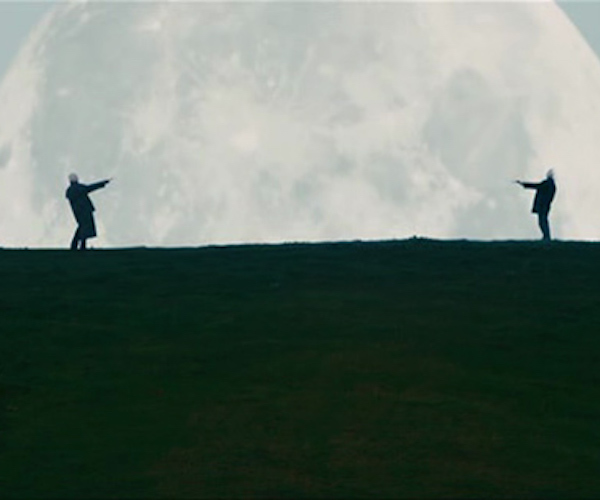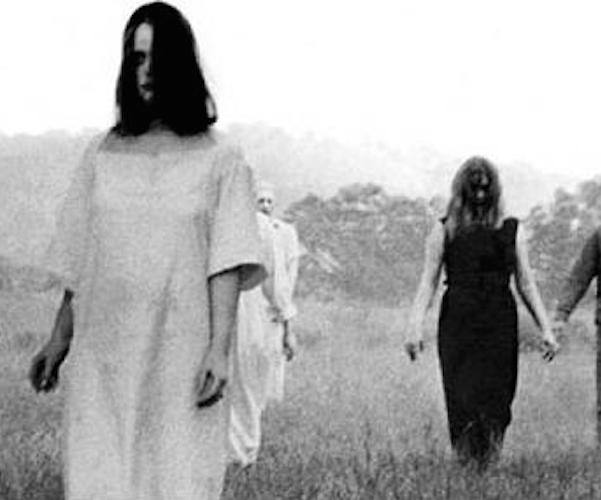Film Tribute: George Romero — A Legacy of Blood, Invention, and Survival
Even after death, the human instinct is to kill or be killed.

A scene from the film “Survival of the Dead.”
By Peg Aloi
Is it possible to thoroughly describe the influence of filmmaker George Romero on cinema, on horror, on culture? Hard to say, given how absolute and encompassing it has been. Romero died this week at age 77, from cancer, and his passing has ignited a fascinating conversation on his cinematic legacy as well as the deeply personal connections that many fans have to his work. Look for repertory theatres near you to host programs in the coming months celebrating his career.
I can honestly say my life was never the same after I viewed Night of the Living Dead for the first time in college. We had a wonderful 35mm film program called “Kino” that showed contemporary ‘classics’ such as A Clockwork Orange (I had to walk out for a bit because I was kinda stoned and it was super disturbing) and Excalibur (students who were members of the Society for Creative Anachronism showed up in medieval gowns and suits of armor). When Romero’s debut effort was screened, in stark black and white, I recall lots of loud screaming — half in hilarity and half in horror — particularly during the scenes where the ghouls (they were not called “zombies” then) were hungrily devouring living humans. The stark but beautiful black and white photography (purely a budgetary choice, not an aesthetic one) made these gruesome scenes even more disturbing and nightmarish.
Later, after repeat viewings, it occurred to me that the flesh-eating ghouls (the living dead) could be seen as metaphors for America’s ‘Others.’ Released in 1968, at the height of the era’s social upheaval, Romero’s film reflects the cultural conflicts of the time: an independent, intelligent black man (Duane Jones) fights for survival with a suburban nuclear family, a young couple who might be hippies, and a young woman dressed like a wealthy urbanite. As they protect themselves from an unthinkable threat, grappling with shock and fear as they put together barricades and makeshift weapons, their arguments and struggles for dominance reflect the issues of the day: sexism, racism, socioeconomic inequity. The space program was indirectly cast in a negative light (or was that “radiation” from “Venus” some sort of commentary on the burgeoning “Free Love” movement?). The staggering crowds of undead are seen as “all messed up” by law enforcement, a possible nod to the anti-war protestors who were freely experimenting with drugs. Echoes of Vietnam and civil rights mayhem also figure in as we see a martial law situation take hold, in which both living and dead are cut down indiscriminately by white, rural residents channeling a small-town militia vibe.
Romero continued to develop this political themes and his skills as a director. Ironically, as the budgets for his productions rose, his work became starker. For example, 1978’s Dawn of the Dead (released the same year as his under-seen vampire tale Martin) features a shopping mall overrun with ghouls, a blatant send-up of our country’s consumption-obsessed culture. 1985’s Day of the Dead commented on the paranoia generated by Ronald Reagan’s belligerent build-up of nuclear weapons as well as instability in Libya, the Middle East, and elsewhere around the globe. The plot revolves around a group of military and government-affiliated scientists hiding in an underground bunker from the zombie-filled world they may have had a hand in creating.
For Romero, the reasons behind the re-animation of the dead matter less than the ways people survive the catastrophe and try to create a future for themselves. Despite making a number of films outside his “dead” franchise, Romero continually returned to the theme, focusing on it almost exclusively in the years before his death, when his rapidly failing eyesight compelled him to work faster. The film many consider the most savvy and prescient of his franchise, 2005’s Land of the Dead, featured an excellent cast (including Dennis Hopper and John Leguizamo) and an unusually compelling urban setting: a city’s streets are divided into the haves and have-nots: people either live on the edge of poverty or hang out in well-appointed high rise towers reserved for the rich, who are safe from the hordes of zombies surrounding the city. The horrors of economic inequity are writ large. Romero’s allegory mirrors the real-life diminishment of economic opportunity as well as the growth of hardship; emotionally, he was tapping into the widespread fear and unrest in the general population. In this case, the beast at the door is literally a slavering monster — but so what? Romero’s scenario satirized the greedy, sociopathic politicians and executives who had created an increasingly-desperate situation.
Two years after Land of the Dead, Diary of the Dead presented a zombie apocalypse captured for posterity on video and social media. The pressures of recording the bloody chaos on camera becomes a part of the film’s drama, as urgently felt as the immediate physical dangers posed by the hungry zombies. The narrative also focuses, in a revealing way, on a group of young survivors (millennials?); their need for community — in a world where the internet is absolute but also vulnerable — overcomes their desire for safety.

A scene from the film “Night of the Living Dead.”
Romero’s final film, 2009’s Survival of the Dead, was also the first film he released with a Pay Per View option that allowed many bloggers and reviewers to weigh in immediately after its release. Sadly, because there is a glut of writers in the horror genre who are not necessarily thoughtful critics, the negative reviews seriously affected the film’s reception. It’s an odd story, to be sure: two feuding families are as concerned with their own personal antagonisms as they are with the occasional threat from the living dead (who are rarely encountered in this remote enclave). It’s not clear where we are in the world: Canada? Nova Scotia? There’s an old world Celt vibe to one family’s speech. In one chilling scene, a young woman, who enjoys riding horses, encounters the possibility that animals as well as humans may soon be part of the hordes of the living dead.
Romero invites us to consider the questions inevitably posed by zombie narratives: who are these walking dead, really? Why do we fear them so and why, in order to protect ourselves, are we moved to feats of amazing bravery and acts of shameful cowardice? There are two camps of survivors in Romero’s stories: those who fight to protect others, and those who are only out for themselves. The director examines the unstable relationship between morality and humanity when our daily lives are radically imperiled.
Survival of the Dead posits an outcome that manages to be both symbolic and eerily plausible. Its swan song statement reflects our current zeitgeist of alienation and paranoia. The film’s final shot is iconic: in profile against a rising (and enormous) full moon, two men, presumably at a place as far north as it is possible to go, stand in a field pointing guns at one another. The pair may be reanimated from the dead — they are chained to posts for eternity, locked in an eternal feud. They are acting out an elemental desire. Even after death, the human instinct is to kill or be killed. We owe Romero an enormous debt for his years of creating entertainment that is also visionary: ironically, the roots of the coming human apocalypse lie deep in human nature. Perhaps a day will come when we will put his ghastly warnings — mitigated by inspiring acts of bravery and compassion — to good use.
Peg Aloi is a former film critic for The Boston Phoenix. She taught film and TV studies for ten years at Emerson College, and currently teaches at SUNY New Paltz. Her reviews also appear regularly online for The Orlando Weekly and Diabolique. Her long-running media blog “The Witching Hour” has recently been moved to a new domain: themediawitch.com


I had no idea Romero had done so many films as variations on a theme, as it were. Looks like we’ll have to do a “Dead-a-thon”!
A fine idea! I felt that he had many things to say within this genre and was hurrying to say them before his sight failed him….